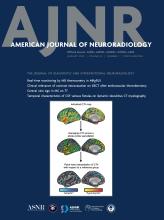We thank M. Tortora and F. Pacchiano for their interest in our recent study on using a coarse-to-fine deep learning model for automated segmentation of intracranial thrombus on NCCT and CTA in patients with acute ischemic stroke (AIS). We agree that accurate segmentation and quantification of intracranial thrombus in patients with AIS is complex and likely influenced by many pathophysiologic factors, such as calcifications, acute hemorrhagic, aneurysm, postischemic defects, and hyperattenuated media signs, which usually have image characteristics similar to those of intracranial thrombus and could be concurrent in the clinical scenario of suspected AIS.1,2
However, our study aimed to develop an automated segmentation tool to replace manual delineation to segment thrombi from images of patients with AIS with confirmed large-vessel occlusion in the MCA region. This tool is the first step in assessing thrombus characteristics such as radiomics, location, length, volume, and permeability, because these image features could be used to predict recanalization with IV alteplase and first-attempt recanalization with thromboaspiration.3,4 In this regard, we included only patients with anterior circulation occlusions, excluding patients with posterior and basilar occlusions and those with complex pathophysiologic factors. In addition, we deliberated using thin-section noncontrast CT and CTA as input to eliminate image interference, such as artifacts in downstream radiomics analyses.
An interesting finding in our article is that our trained model can detect and segment thrombi in patients with small- and medium-sized vessel occlusions even if those images were not used for training. Although this experiment shows the great generalizability of our model, it was only tested on a limited data set. More training images with different pathologies and image quality are required to refine our model, and more comprehensive evaluations are also desired to incorporate the model into current clinical routine.
Footnotes
This work was supported by Natural Science Basic Research Plan in Shaanxi Province of China (Program No. 2021JM-413), Distinguished Young Scholars of the National Natural Science Foundation of China (Overseas), and National key research and development program (No. 2022YFE0209900).
Disclosure forms provided by the authors are available with the full text and PDF of this article at www.ajnr.org.
- © 2024 by American Journal of Neuroradiology












